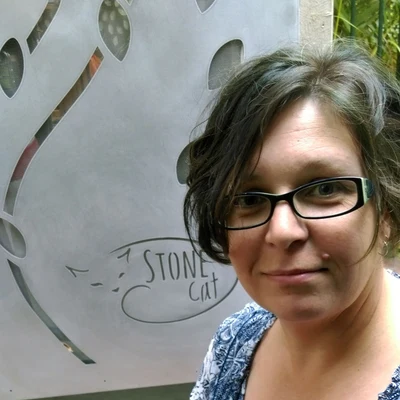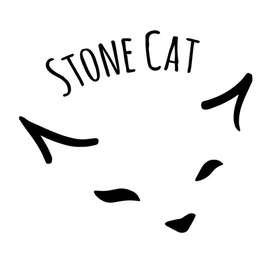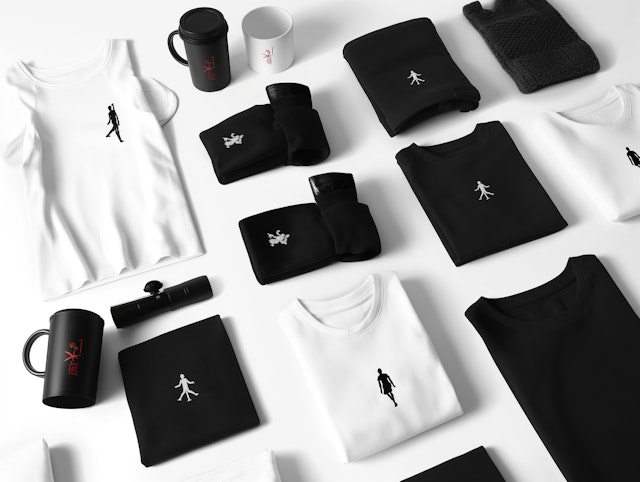How StoneCatCeramics got started
Introduce your Etsy shop and tell us your story. How did you begin and decide on what to sell on Etsy, and how do you create your products?
As with a lot of Etsy sellers, my store, Stone Cat Ceramics, started as a hobby. I had never sold anything and didn’t even have my own pottery wheel, but I loved to do it. This hobby turned into a full-time business when the funding for my previous job as a research scientist disappeared at the beginning of 2015. I was ready for a complete career change at that point, so I jumped in with both feet. That year, I set up my little studio at home with a wheel, a kiln, and a business plan to make modern, minimal ceramics. That business plan went out the window almost immediately when I decided to mix in my love for history by making mugs and bowls inspired by Viking-era ceramics and selling them at a local medieval fair. They sold really well, and so my business plan evolved to focus on archaeologically-inspired objects.
It took me the entire year of 2015 to build up some inventory and set up an Etsy store with a few personalized made-to-order options.I make everything by hand and do all the processes along the way myself, so it took a lot of organizing and figuring out the optimal and most efficient way of doing things. When I launched at the end of 2015, the first thing I sold was a custom mug with personalization. This first Etsy sale now appears to be prophetic, as my sales quickly became dominated by personalized mugs. Over time, I expanded my product range, keeping the archaeologically inspired Viking-era framework and adding authentic runic inscriptions and several mug designs.
Favorite items
What are your favorite items? What makes these so special? Why do you think these items might be selling well?
The large mugs (500 mL/17 fl oz) are my favorites because they are really nice to make, especially the curves. There’s just something special about shaping something with your hands and seeing it end up with the perfect, undulating curves that you set out to make. Sometimes the shape is just a little wrong, so I have to reshape it; but, when it’s right, you can just see it, and those curves are beautiful to me. The large mugs are always the best sellers, especially in the Norwegian Viking mug style, probably because that style is a lot different from the usual, run-of-the-mill mug style.

Getting sales on Etsy
How long did it take for you to earn your first sale and how do you currently attract customers to your Etsy shop?
My first sale came within a week of starting, but after that they came slowly—a few a month—until the Christmas season, when things started to pick up. Eventually I moved to mostly "made-to-order" items with many personalization and color options, which is what I think drew people to my items as gifts. I haven’t purchased any advertising for the last 5 years or so. I tried out Google Ads, but it didn’t increase sales at the time, and I’ve never had Etsy Ads. My Instagram is sorely neglected, and I don’t engage with the other social media. For the last few years, I have had so many orders just from organic Etsy searches that I can’t keep up, so I don’t want to drive more traffic right now.
I think it’s certain characteristics of my items that draw customers. Firstly, it’s that their shape, the handle, and the way I glaze them are distinctly different from most other mug styles. Secondly, I offer many options in size and glaze color so that a customer can make something unique to them. And, thirdly, the personalization of the mugs, either with a customer’s own text and/or some of the "symbols" I have (birds, cats, leaves, etc.) that are inscribed into the clay, again helps the customer make something unique.
Managing StoneCatCeramics
How do you manage your shop? Are you running solo or do you have any team members? What tools or services do you use to run your shop and how do you handle fulfillment?
Up until 2023, I was on my own, but now my husband is helping me out with a few things since I’ve become so busy. I use a spreadsheet of orders to help me keep track of what needs to be made and when, and it also helps with packing by calculating the number and type of boxes that I need, what notes need to be written and to whom, and where everything is being sent. It's a complicated spreadsheet workbook, but it ensures that I put the right personalization or inscription on the right-sized and style mug, and that it's glazed in the correct color. I also use a spreadsheet to keep track of all the costs that go into making my mugs so I can figure out accurate pricing. My day-to-day tasks are handled by ToDoist, which I use to schedule all the different tasks involved in making and packing, and I couple this with Notion, where I keep detailed notes of everything else: research into new items and ideas, glaze recipes, administration, notebooks on different aspects of making to keep track of changes and experiments, supplier details, analyses of yearly sales, inventory tracking for all the packing boxes, etc.
Since I do all the packing myself (with some help from my husband now), it’s evolved over the years. I started with off-the-shelf box sizes but quickly moved to custom-made boxes that specifically fit my items. Those boxes aren’t fancy—just plain boxes that I have to tape up—but they make packing each item more efficient. I’ve now also turned one of the spare bedrooms in my house into a packing room with a big table and lots of space. That’s a bit of a luxury, but it’s so worth it to have everything in one place and immediately accessible.
The future of StoneCatCeramics
What goals do you have for your shop in the future?
With my husband’s help, I hope to increase the production capability this year so that I can keep up with orders, have more "Ready-to-Ship" items, and finally stop working 7 days a week. He’s also a woodworker, so we’re working on complementary wooden items that can be sold with the ceramics. Ideally, we’d like to make enough to have a modest wage for two people, and our plan to do this is through streamlining processes and sharing the workload. In theory, it should work, but 2023 is our test year, so we’ll see how it goes! I have been wanting to introduce new designs that I’ve been thinking about for years but just haven’t had the time to implement, so hopefully this year I’ll finally have some time to work on new things.
Advice for new sellers
What’s your advice for a new seller starting an Etsy shop?
I’m no Etsy expert, but I would suggest that sellers focus on the uniqueness of their products. You can do all the marketing in the world, but if your item is identical to 10 others, then most buyers will focus on price. If your item is different, then you will stand out and find your customers that way. Finding that unique characteristic may not be easy, and it may take a few tries and many months or years to find it, but you need to stand out amongst the sea of Etsy sellers out there today. I’m a big proponent of having lots of options—lots of size, style, and color choices, as well as the potential for personalization—since that has worked for me so far.
The only other advice I can give from personal experience is to expect your shop to develop into a profitable business over years, not overnight. So, at the beginning, don’t waste money on things you don’t need. For example, custom-printed, branded boxes aren’t worth the investment right away. Sure, they’ll make the unboxing experience nice for your customer, but they are also a huge initial outlay for an untested product, will increase the price of your item by a relatively large amount (these boxes aren’t cheap! ), and are a purely aesthetic, not functional, choice. At the beginning, pretty up your boxes another way and focus on your product, not the packaging. Making wise investment choices at the beginning will help you later on.
Some sellers really get inspired by hearing numbers. Feel free to share these if you like.
Question: How much is your monthly revenue?
Answer: US$2860 per month total, for a profit of about US$1300
Question: What is your average profit margin?
Answer: 45%
Question: What is your shop’s conversion rate?
Answer: For 2022: 2.2%










